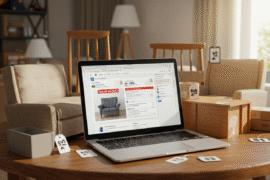This article may contain references to products or services from one or more of our advertisers or partners. We may receive compensation when you click on links to those products or services. Nonetheless, our opinions are our own.
The information presented in this article is accurate to the best of our knowledge at the time of publication. However, information is subject to change, and no guarantees are made about the continued accuracy or completeness of this content after its publication date.
Selling used books can be both financially rewarding and emotionally satisfying. Whether you’re looking to declutter or connect with fellow readers, here are eight effective strategies to help you turn your bookshelf into extra income.
- Utilize Online Marketplaces
- Visit Local Used Bookstores
- Join Community Groups
- Host a Garage Sale
- Participate in Book Fairs or Flea Markets
- Leverage Social Media Platforms
- Trade Books with Friends
- List on Niche Sites
- Create Bundle Discounts
- Provide Detailed Descriptions & Quality Photos
- Stay Competitive with Pricing
- Offer Free Shipping Options When Possible
- Frequently Asked Question (FAQs)
- What are the primary challenges in selling a very large collection (10,000+) of used books?
- What are some potential avenues for selling a large used book collection?
- Is it realistic to expect a high financial return when selling such a large collection?
- What role does the condition of the books play in their potential sale and value?
- Should the seller attempt to create an inventory of the collection? If so, what level of detail is necessary?
- Are donations to libraries or other organizations a viable solution for a collection of this size?
- What practical first steps should the seller take when faced with this large collection?
- What non-financial factors should the seller consider during this process?
- Recommended Reads
Utilize Online Marketplaces
Websites like eBay, Amazon, and AbeBooks make listing your used books for sale easy. You can reach a wider audience and often sell at competitive prices.
When it comes to selling your used books, online marketplaces offer a convenient and effective platform. Here are some compelling reasons to consider these websites:
Wider Audience Reach
Unlike local sales, platforms like eBay and Amazon have millions of potential buyers worldwide. This increased exposure can lead to quicker sales.
User-Friendly Listing Process
These sites typically provide simple tools for listing items; you can upload pictures and descriptions with just a few clicks.
Competitive Pricing
Many users on these platforms actively compare prices, allowing you to set competitive rates that attract buyers without undervaluing your books.
Semi-Automated Transactions
With integrated payment solutions, transactions are streamlined; once a buyer commits, the marketplace securely manages the payment process.
This model not only helps clear your shelves but also provides an excellent opportunity for extra income while connecting you with fellow book lovers worldwide.
Visit Local Used Bookstores
Many independent bookstores buy used books or offer trade-in options where you can exchange them for store credit, making it a practical and community-driven choice.
Visiting local used bookstores is one of the most rewarding ways to declutter your bookshelf. These independent shops often have a community-centric approach, making it easy to turn your unused books into something more valuable—a chance to discover new titles or earn store credit. Benefits include:
Support Local Businesses
Selling or trading at an independent bookstore directly supports your local economy and helps sustain small businesses.
Sustainable Choices
Recycling your old books contributes to a more sustainable environment and reduces the demand for new book production.
Selective Curation
Many local stores handpick their inventory based on what resonates with their clientele, often resulting in high-quality selections that reflect community interests.
Camaraderie and Connection
Engaging with passionate staff and fellow readers can enrich your experience. They might offer recommendations you wouldn’t come across otherwise.
This approach allows you to clear out space while benefiting from fresh reading material without much cost. It’s not just about selling—it’s about being part of a literary community that thrives on shared stories.
Join Community Groups
Explore local community groups on Facebook or platforms like Nextdoor, where you can sell directly to neighbors interested in your collection.
Connecting with local community groups offers a great way to find interested buyers. These platforms provide direct, no-middleman access to people in your area who share your interest in books.
Join Local Book Groups
Look for groups specifically dedicated to buying, selling, or trading books. Members are usually eager readers looking for their next great read.
Create Eye-Catching Posts
Include clear photos and descriptions highlighting special features such as signed copies or rare editions.
Interact with Your Community
Engage with potential buyers by responding promptly to inquiries and offering personalized recommendations. This makes your posts stand out and builds trust.
This approach speeds up the sales process while fostering a sense of connection with fellow book lovers in your neighborhood.
Host a Garage Sale
If you want to part with several titles, consider hosting a garage sale. This allows you to engage with buyers face-to-face and clear out more space at once.
A garage sale can be a simple and effective way to declutter while selling your used books. Here’s how to make the most of it:
Choose the Right Day and Time
Weekends usually attract more foot traffic. Aim for Saturday mornings or early afternoons when people are more available.
Create Attractive Displays
Arrange your books neatly by genre, author, or condition. An organized layout makes browsing enjoyable and efficient.
Promote Your Sale
Use local community boards, apps like Nextdoor, and social media platforms to advertise beforehand.
Pricing Strategy
Set competitive prices based on condition and original retail price. Consider offering bulk discounts to encourage multiple purchases.
The personal interaction allows buyers to hear about stories behind certain titles or get recommendations—plus, cash sales keep things straightforward.
Participate in Book Fairs or Flea Markets
Look for opportunities in your area to set up a booth at book fairs or flea markets, allowing enthusiasts to browse your selection in person.
Book fairs and flea markets attract a diverse audience, including avid readers and collectors. Setting up a booth allows you to showcase your collection and connect with potential buyers.
Research Upcoming Events
Check local community calendars or social media groups for details on upcoming fairs or markets.
Create an Attractive Display
Present your books neatly using colorful banners or tablecloths to make your booth inviting.
Offer Bundled Deals
To attract attention, encourage sales with package deals, such as “buy three, get one free.”
Engage with Customers
Be approachable and willing to share insights about the books you’re selling. A passionate conversation can increase trust and lead to a sale.
Face-to-face engagement creates a more memorable and impactful experience for buyers, often leading to better results.
Voted "Best Overall Budgeting App" by Forbes and WSJ
Monarch Money helps you budget, track spending, set goals, and plan your financial future—all in one app.
Get 50% OFF your first year with code MONARCHVIP
Use Instagram or Twitter to showcase the books you’re selling by posting attractive photos and engaging descriptions.
On Instagram, focus on visually appealing images that highlight unique features of each book. Use natural lighting and creative backgrounds to draw attention. Pair the pictures with short, engaging captions that include details and personal insights.
On Twitter, use the platform’s fast-paced format to share concise, eye-catching posts with visuals or links to purchase pages. Engage with hashtags like #usedbooksale and #bookcommunity to expand your reach. Participate in discussions and reply to inquiries to build credibility.
This method allows you to tap into a broader audience through personal networks while fostering connection and trust.
Trade Books with Friends
Organize book swaps among friends; not only do you get new reading material without spending money, but it’s also an enjoyable social event that promotes a culture of sharing.
A book swap is a cost-effective and meaningful way to refresh your library while connecting with others. To host a successful event:
Set Guidelines
Agree on how many books each person should bring and whether to include specific genres.
Create a Cozy Space
Set up a comfortable area for browsing, such as a living room or backyard with seating.
Add Some Snacks
Providing refreshments or encouraging guests to bring snacks creates a relaxed and fun environment.
Ask participants to talk briefly about their books. Personal stories often spark deeper conversations and enhance the experience.
This format encourages discovery and reduces clutter while deepening bonds with friends. It’s also an eco-friendly way to enjoy new literature.
List on Niche Sites
Consider niche sites dedicated to specific genres (like rare collectibles), which may better connect you with readers looking for unique finds.
Niche websites can help you reach audiences that value specific types of books. Benefits include:
Targeted Audience
Reaching readers with a specific passion, such as rare finds, academic texts, or graphic novels, increases the likelihood of them making a purchase.
Specialized Marketplaces
Platforms like AbeBooks cater to collectors, while others focus on limited genres. This alignment boosts your chance of selling to the right customer.
Community Engagement
Many niche platforms also support communities of collectors, creating trust and a culture of informed buying and selling.
This method can yield higher returns for unique or valuable titles while providing a sense of purpose in connecting with readers who truly appreciate the books.
Create Bundle Discounts
Selling multiple books as bundles at discounted rates encourages buyers to purchase several titles at once.
Bundling is a strategic way to boost your average sale value while appealing to buyers seeking a deal.
Themed Collections
Group books by topics like classic literature, cooking, or self-improvement to appeal to specific interests.
Popular Picks
Bundle your bestsellers together to create a high-demand offering.
Mystery Packs
Sell randomly selected bundles at a lower price. The surprise element can be fun and enticing.
Bundling simplifies decision-making for buyers and introduces them to authors or genres they might not explore otherwise. Promote these bundles through social media and email to maximize engagement.
Provide Detailed Descriptions & Quality Photos
When listing online, invest time crafting informative descriptions and high-quality images of each book; this builds trust and attracts potential customers quickly.
Key Details to Include
Condition: State whether the book is new, gently used, or shows wear.
Edition & Publisher: List edition, year of publication, format, and any special features.
Content Summary: Share a short synopsis or highlight main themes.
Tips for Great Photos
Use Natural Lighting: Avoid glare and show true colors.
Show Multiple Angles: Front, back, spine, and inside pages if relevant.
Avoid Stock Images: Real photos build credibility and authenticity.
Quality listings build trust and drive faster sales by making it easier for buyers to assess what they’re purchasing.
Stay Competitive with Pricing
Research comparable listings beforehand to stay aware of market trends so your pricing remains fair and appealing.
Identify Competitors
Browse online marketplaces and local shops to compare pricing on similar titles. Note differences in edition, condition, and format.
Track Trends
Use tools like BookFinder or eBay’s sold listings to monitor pricing trends over time.
Adjust as Needed
If your pricing is significantly higher than similar items, reduce it to increase buyer interest without undercutting too much.
Pricing research helps ensure you stay competitive while meeting customer expectations—significant for bargain hunters.
Offer Free Shipping Options When Possible
Consider including free shipping thresholds—this can incentivize purchases while enhancing customer satisfaction without significantly cutting into profits.
Smart Implementation Tips
Set a Minimum Threshold: Encourage larger purchases by offering free shipping on orders over a certain amount.
Factor Costs into Pricing: Slightly increase product pricing to cover shipping while still advertising it as free.
Promote Strategically: Use limited-time offers or special promotions to create urgency and boost order size.
Free shipping remains a powerful incentive to increase customer loyalty and average order value.
Frequently Asked Question (FAQs)
What are the primary challenges in selling a very large collection (10,000+) of used books?
The main challenges include the sheer volume, which makes individual listing and shipping impractical for a quick sale. Determining the value of each book requires significant time and effort, and the collection may contain a large percentage of common or undesirable books, yielding little profit. Storage conditions can also impact value due to potential mold, water damage, or pest infestation. Finding a single buyer for such a large and potentially uncurated lot is difficult, and bulk buyers typically offer very low prices.
What are some potential avenues for selling a large used book collection?
Several options exist, each with pros and cons. Selling individually online (e.g., Amazon, eBay, Abebooks) can yield the highest returns for valuable books but is time-consuming. Selling in bulk to used bookstores or bulk buyers offers a quick solution but at a low price. Hosting a large book sale (e.g., yard sale or through a tag sale company) can move many books. Donating to libraries or non-profits might be an option, but they may have restrictions on what they accept and might only sell the books themselves. Listing genre-specific or visually appealing lots online (e.g., “ten green books” on Etsy) could attract niche buyers.
Is it realistic to expect a high financial return when selling such a large collection?
Generally, it is unrealistic to expect a high financial return for a very large, uncatalogued used book collection. The market for most used books is saturated, and the labor involved in identifying and selling valuable items is substantial. Bulk buyers and used bookstores typically offer pennies on the dollar. While there might be some valuable books within the collection, they could be difficult to identify without significant effort. The overall condition of the books, especially if stored in non-ideal environments, will also significantly impact their value.
What role does the condition of the books play in their potential sale and value?
The condition of the books is crucial. Books with mold, water damage, ripped pages, or damaged covers are generally considered worthless and difficult to sell or even donate. Books stored in non-climate-controlled environments are particularly susceptible to damage. Only books in very good or collectible condition are likely to fetch significant prices, especially if they are first editions, signed copies, or rare titles. Magazines, unless vintage or of niche interest and in excellent condition, typically have little to no resale value.
Should the seller attempt to create an inventory of the collection? If so, what level of detail is necessary?
Creating some form of inventory is highly recommended, even if a full catalogue is too time-consuming. At a minimum, identifying potential areas of value (e.g., older hardcovers, specific genres, known authors) would be beneficial. Recording the barcode/ISBN (if available), condition, and potentially the title/author is essential for online selling. For bulk sales, having a general idea of the types of books (e.g., genres, hardback vs. paperback) can help in discussions with potential buyers. Prioritizing the identification of potentially valuable items (first editions, signed copies, etc.) can be the most efficient use of time.
Are donations to libraries or other organizations a viable solution for a collection of this size?
Donating is an option, but libraries and other non-profits often have limited capacity and specific criteria for accepting donations. They may not want a large, unsorted collection and might only accept a small number of books at a time. They also typically prefer books in good condition that fit their collection needs or can be sold for fundraising. Simply dropping off a massive, unvetted collection can create a burden for these organizations, as they may need to spend time and resources sorting and disposing of unwanted items. Contacting potential donation recipients in advance to understand their policies is crucial.
What practical first steps should the seller take when faced with this large collection?
Practical first steps include assessing the storage conditions and identifying any signs of damage like mold or pests. A preliminary sort to remove damaged or unwanted items (e.g., very old periodicals, outdated textbooks in poor condition) can help reduce the volume. If possible, setting aside any books that are suspected to be valuable for further research is advisable. Contacting local used bookstores or tag sale companies for initial consultations and advice on handling such a large collection can also be helpful.
What non-financial factors should the seller consider during this process?
Beyond financial returns, the seller should consider the time and effort involved in each selling method. The emotional aspect of parting with a long-term collection, especially for the original collector, is also significant. The goal of simply getting rid of the books quickly versus trying to maximize potential returns will influence the chosen strategy. As highlighted in the initial post, finding a solution that respects the mother’s wishes and minimizes stress for both her and the person managing the sale is important.

Reviewed and edited by Albert Fang.
See a typo or want to suggest an edit/revision to the content? Use the contact us form to provide feedback.
At FangWallet, we value editorial integrity and open collaboration in curating quality content for readers to enjoy. Much appreciated for the assist.
Did you like our article and find it insightful? We encourage sharing the article link with family and friends to benefit as well - better yet, sharing on social media. Thank you for the support! 🍉
Article Title: Best Way to Sell Used Books
https://fangwallet.com/2025/03/27/best-way-to-sell-books/The FangWallet Promise
FangWallet is an editorially independent resource - founded on breaking down challenging financial concepts for anyone to understand since 2014. While we adhere to editorial integrity, note that this post may contain references to products from our partners.
The FangWallet promise is always to have your best interest in mind and be transparent and honest about the financial picture.
Become an Insider

Subscribe to get a free daily budget planner printable to help get your money on track!
Make passive money the right way. No spam.
Editorial Disclaimer: The editorial content on this page is not provided by any of the companies mentioned. The opinions expressed here are the author's alone.
The content of this website is for informational purposes only and does not represent investment advice, or an offer or solicitation to buy or sell any security, investment, or product. Investors are encouraged to do their own due diligence, and, if necessary, consult professional advising before making any investment decisions. Investing involves a high degree of risk, and financial losses may occur including the potential loss of principal.
Source Citation References:
+ Inspo
There are no additional citations or references to note for this article at this time.












































